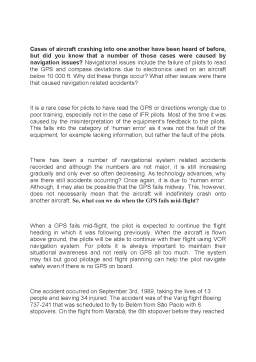Extras din referat
History
The first liquid compasses specifically made for aircraft were introduced in 1909 but, although practical, were very rudimentary. It was only until the 1930s when liquid compasses made for aircraft became practical, with the compass only requiring four seconds to settle compared to over 30 seconds of previous models.
The compass
It's the only instrument in most light aeroplanes that indicates the correct heading. The direction indicator (DI) or directional gyro (DG) is simply gyro-stabilised and can be set to any heading. To be of any value it must be manually aligned with the magnetic compass on a regular basis.
In using the magnetic compass for navigation purposes there are more considerations than just the turning errors.
The magnetic compass displays several errors in its use, most of which the DI eliminates. If, for any reason, the DI becomes unusable, the pilot will need to be able to turn onto and maintain a compass heading.
The cause of compass errors is not as important as how to compensate for those errors in flight. A basic understanding of the causes of compass errors is all that is required.
Basic malfunctions
Variation
The earth has a geographical (true) North Pole and a geographical (true) South Pole.
A magnetic field exists around the earth, produced by the equivalent of a very large bar magnet within the earth (see Figure 1). This results in a magnetic North Pole and a magnetic South Pole.
The magnetic poles are not in the same places as the true poles; however, currently they are close, enabling us to use magnets to navigate around the world.
The angular difference between true north and magnetic north at any point on the earth is called variation. This difference is more relevant when navigating because maps are drawn with reference to true north, and the aircraft is navigated by reference to magnetic north. This will be covered during future navigation lessons.
Deviation
When the bar magnet or magnetic compass is acted on by a magnetic field other than the earth's, the magnet deviates. Most metal objects or electrical fields produce a magnetic field that will cause the compass to read incorrectly. This effect is known as deviation. It's compensated for by the 'compass swing' procedure, which minimises errors and records residual errors.
The compass deviation card displays the correction to apply.
Dip
At the magnetic equator, the earth's magnetic field lies parallel with the earth's surface, and a bar magnet would also lie parallel. As the poles are approached, the lines of flux dip down toward the earth's surface, and so does a bar magnet.
Suspending the compass card from a pivot point above the magnet almost eliminates dip.
The pivot arrangement is unstable, so the compass card and magnets are immersed in a fluid that damps out oscillations, and also provides lubrication
Preview document
Conținut arhivă zip
- Accidents caused by the compass malfunction.docx




